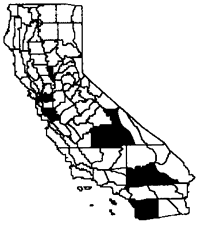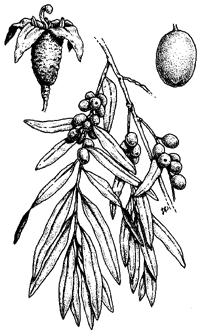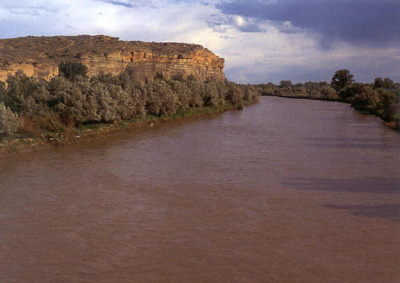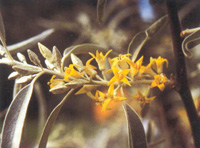|
Elaeagnus angustifolia
|
|
|
|
Scientific name
|
Elaeagnus angustifolia
|
|
Additional name information:
|
L.
|
|
Common name
|
Russian olive, oleaster
|
|
Synonymous scientific names
|
none known
|
|
Closely related California natives
|
0
|
|
Closely related California non-natives:
|
0
|
|
Listed
|
CalEPPC List A-2,CDFA nl
|
|
By:
|
Laurie Deiter
|
|
Distribution
|
|
|
HOW DO I RECOGNIZE IT?
Distinctive features:
|
Russian olive (Elaeagnus
angustifolia) is a perennial deciduous tree up to twenty-three feet tall.
It has flexible, often spiny branches with dark, smooth bark, small, narrow,
silvery leaves, and small clusters of aromatic yellow flowers that produce a
hard olive-shaped fruit.
åÊ
|
|
Description:
|
| Eleagnaceae. Tree to 23 ft (6.9 m) tall, especially in cultivation. Branches: flexible, often spiny, reddish brown, coated with gray and scaly pubescence, becoming glabrous with age. Leaves: alternate, blades simple, narrowly ovate to lanceolate, 1-3.5 in (2.5-9 cm) long, tip pointed to blunt, margins entire and commonly undulate, upper surface light green and covered with stellate pubescence, lower surface silvery white and densely covered with scales with edges that fray to appear like stellate pubescence, petiolate 1/4-1/2 in (6-13 mm). Flowers: yellowish green sepals, sepals 4, fused below, lobes spreading or reflexed to erect, silvery-scaly outside, yellowish green inside, petals none, fragrant. |
|
Fruit: drupe-like, oval 0.5-0.6 in (13-15
mm) long, mealy, greenish yellow to brown, densely covered with mealy scales.
Seed: brown, oblong, 1/4-1/2 in (6-13 mm) (Stubbendieck et al. 1994).
åÊ
|
|
WHERE WOULD I FIND IT?
|
In California, Russian olive is found in
disturbed, seasonally moist places, generally below 5,000 feet (1500 m)
elevation. It exists in the San Joaquin Valley, San Francisco Bay Area, southern
Sierra Nevada, San Diego County, and parts of the Mojave Desert near springs
(Hickman 1993). It is common in riparian zones and floodplain forests and
sub-irrigated pastures and irrigation ditches, but is also found in drier sites
such as railroad beds, fence lines, along highways, and in grasslands.
Russian olive tolerates a wide range of soil and moisture
conditions, from sand to heavy clay, and can withstand flooding and silting. It
grows best in deep sandy or loamy soils with only slight salt and alkali
content. There are dense, healthy stands in river bottoms where the water table
is seldom more than two feet (0.6 m) below the surface, but it survives
considerable drought (Borell 1971). Russian olive is tolerant of considerable
salinity or alkalinity, although it prefers slightly alkaline soils with low to
medium concentrations (100-3,500 ppm) of soluble salts (Olson and Knopf 1986).
It can withstand temperatures ranging from -50 degrees F (-45 degrees C) to 115
degrees F (46 degrees C). It occurs from sea level to at least 8,000 feet
elevation in several western states. Russian olive is somewhat shade tolerant
and can withstand competition from other shrubs and trees (Borell
1971).
åÊ
|
|
WHERE DID IT COME FROM AND HOW IS IT SPREAD?
|
Native to southern Europe and western Asia,
Russian olive was introduced into North America as an ornamental in the early
1900s (Christensen 1963). A popular landscaping tree, it escapes cultivation
readily. Russian olive was actively promoted for many years for windbreaks, soil
stabilization, and wildlife habitat improvement. It spreads by seed, primarily
ingested by birds and deposited elsewhere. Small mammals also spread seeds by
gathering and stockpiling them (Olson and Knopf 1986).
åÊ
|
|
WHAT PROBLEMS DOES IT CAUSE?
|
Russian olive has escaped cultivation and
naturalized in seventeen western states, colonizing edges of riparian zones
first (Knopf and Olson 1984). It is able to regenerate under a wide variety of
floodplain conditions with little or no mortality after seedling development.
Native cottonwoods and willows, having narrow germination and establishment
requirements and intolerant of shade, are unable to regenerate under advancing
populations of Russian olive (Shafroth et al. 1994). Once established, Russian
olive increases stream bank stabilization and reduces river stage levels,
creating a relatively dry upland site with Russian olive as the climax species.
Russian olive stands provide lower-quality habitat for terrestrial vertebrates
compared to native riparian woodlands (Howe and Knopf 1991). Bird species
richness is lower in Russian olive stands than in native riparian forest. By
displacing native trees, monospecific stands of Russian olive reduce the
availability of nesting cavities and insect food for many native birds (Shafroth
et al. 1994).
åÊ
|
|
HOW DOES IT GROW AND REPRODUCE?
|
Russian olive reproduces by seed, which is usually produced after trees are four to five years old. It generally flowers from May through June (Stephens 1973, Vines 1960). The fruits mature from August to October and remain on the tree throughout the winter or until the crop is consumed (Olson 1974, Borell 1971). Seeds are ingested with the fruit by birds and small mammals and dispersed in their droppings. The outer layer of the seed is impermeable to digestive juices. Seeds can remain viable for up to three years and are capable of germinating over a broad range of soil types (Knopf and Olson 1984). Germination is enhanced by stratification in moist sand for ninety days at 41 degrees F (5 degrees C) (Vines 1960). Spring moisture and slightly alkaline soil tend to favor seedling growth (Olson 1974).
|
Russian olive is a deep-rooted tree with a medium to rapid growth rate. It can grow up to six feet (1.8 m) per year (Williams 1991) and creates a well developed lateral root system (Borell 1971). It can resprout from from the root crown and sends up root suckers (Williams and Hanks 1976, Bovey 1965). It tolerates a wide variety of growing conditions, making it appealing to consumers for landscaping.
|
(click on photos to view larger image)
|
|
|
HOW CAN I GET RID OF IT?
|
Control methods vary with tree size,
habitat, and use of the area (e.g., agricultural field vs. sensitive wetland).
Removal should be undertaken before seeds are fully developed to prevent further
spread of seeds. Control is difficult once trees mature, so early detection and
control are important.
åÊ
|
|
Physical control:
|
Manual/mechanical methods: Russian olives with small diameters
(3.5 in) can be pulled out with a weed wrench when soils are moist. In certain
situations larger trees can be removed using a tractor/chain. Any remaining
exposed roots should be cut off below ground level and buried. Girdling and
cutting are not effective controls by themselves. The tree may resprout below
the girdled or cut area or along root line.
Fire control: Stump burning has been shown to be successful, but
it is time-consuming compared to other control techniques (Knopf and Olson
1984).
åÊ
|
|
Biological control:
|
Research on biocontrol agents has not been
undertaken for this species.
åÊ
|
|
Chemical control:
|
Most translocating herbicides (e.g.,
glyphosate) are effective at label strength when applied during the growing
season. Some dormant-season herbicides (e.g., imazipyr as Chopper RTUå¨) are
labeled for Russian olive control. Foliar spraying has been successful, as has
injecting herbicide capsules around base of trunk. When injecting herbicides
into the cambium of a standing tree, monitoring should occur the same year to
ensure that the entire tree is affected. Cut-stump treatments can be effective
when combined with burying the stump or painting the cut surface with chemicals.
Cuts should be made as close to the ground as possible and immediately be
followed by 5-10 cc of glyphosate (as Roundupå¨) applied at full strength to the
cambium. For trees that do not have to be removed or immediately taken down,
exposing more than 50 percent of the cambium by cutting into the bark with a saw
or ax close to ground level and introducing herbicides into the exposed areas is
effective. A syringe (size 14 needle) works well for both of these combinations.
Brushing also works, but requires a larger amount of herbicide. Burying a stump
after cutting can also prevent regrowth from the stump, but exposed roots should
be monitored for resprouting. Monitoring regrowth of cut stumps or roots should
be done one year after treatment.
åÊ
|




